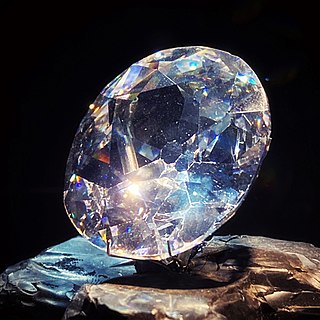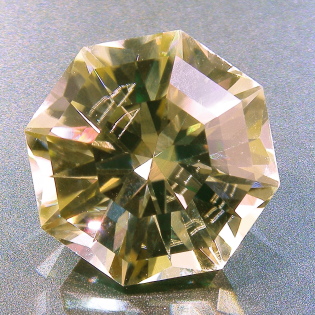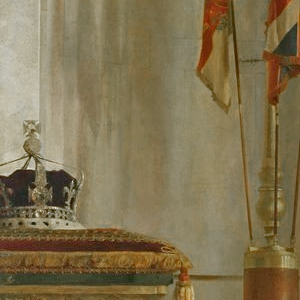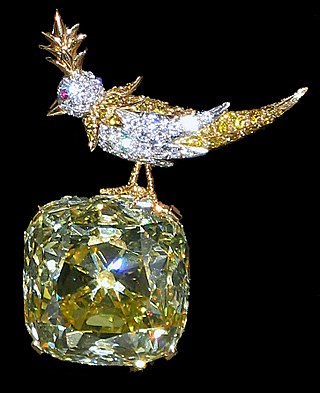
The Koh-i-Noor, also spelt Koh-e-Noor, Kohinoor and Koh-i-Nur, is one of the largest cut diamonds in the world, weighing 105.6 carats (21.12 g). It is part of the Crown Jewels of the United Kingdom. The diamond is currently set in the Crown of Queen Elizabeth The Queen Mother.
Diamond cutting is the practice of shaping a diamond from a rough stone into a faceted gem. Cutting diamonds requires specialized knowledge, tools, equipment, and techniques because of its extreme difficulty.

The Cullinan Diamond is the largest gem-quality rough diamond ever found, weighing 3,106 carats (621.20 g), discovered at the Premier No.2 mine in Cullinan, South Africa, on 26 January 1905. It was named after Thomas Cullinan, the owner of the mine. In April 1905, it was put on sale in London, but despite considerable interest, it was still unsold after two years. In 1907, the Transvaal Colony government bought the Cullinan and Prime Minister Louis Botha presented it to Edward VII, the British king who reigned over the territory. It was then cut by Joseph Asscher & Co. in Amsterdam.

Facets are flat faces on geometric shapes. The organization of naturally occurring facets was key to early developments in crystallography, since they reflect the underlying symmetry of the crystal structure. Gemstones commonly have facets cut into them in order to improve their appearance by allowing them to reflect light.
Hearts and arrows (H&A) diamonds are precision-cut variations of the traditional 57-faceted round brilliant cut. They are cut to "ideal" proportions with good optical symmetry, polish, and a specific faceting pattern. When these factors are present, the result is a near-perfect pattern of eight symmetrical arrows when viewed from the top (crown) and eight symmetrical hearts when viewed from the bottom (pavilion).

A diamond cut is a style or design guide used when shaping a diamond for polishing such as the brilliant cut. Cut refers to shape, and also the symmetry, proportioning and polish of a diamond. The cut of a diamond greatly affects a diamond's brilliance—a poorly-cut diamond is less luminous.

The Crown of Queen Elizabeth The Queen Mother, also known as the Queen Mother's Crown, is the crown made for Queen Elizabeth to wear at her coronation in 1937 and State Openings of Parliament during the reign of her husband, King George VI. The crown was made by Garrard & Co., the Crown Jeweller at the time, and is modelled partly on the design of the Crown of Queen Mary, though it differs by having four half-arches instead of the eight that Queen Mary's Crown originally had. As with Queen Mary's Crown, its arches are detachable at the crosses pattée, allowing it to be worn as a circlet or open crown. It is the only crown for a British king or queen to be made of platinum.

The Crown of Queen Mary is a consort crown that was made in 1911 for the coronation of British queen Mary of Teck. Mary thereafter wore it on occasion in circlet form. It is part of the Crown Jewels of the United Kingdom. It was used again, in a slightly altered form, at the coronation of Queen Camilla on 6 May 2023.

The Jacob Diamond, also known as the Imperial or Victoria Diamond, is a colourless diamond from India ranked as the fifth-biggest polished diamond in the world. The last nizam of the Hyderabad State, Mir Osman Ali Khan, found the diamond in the toe of the shoe of his father at Chowmahalla Palace and used it as a paperweight for a long time. It was bought by the government of India for an estimated $US13 million in 1995. It is cut in a rectangular cushion-cut, with 58 facets, and measures 39.5 millimetres (1.56 in) long, 29.25 millimetres (1.152 in) wide and 22.5 millimetres (0.89 in) deep. The diamond weighs 184.75 carats. Currently, it is kept at the Reserve Bank of India vaults in Mumbai. As part of the Nizam's jewellery exhibition in 2001 and 2007, the Jacob Diamond was a major attraction at Salar Jung Museum, Hyderabad.

The Royal Asscher Diamond Company was founded in 1854 by the Asscher family of gemcutters. The company is responsible for cutting some of the most famous diamonds in the world including the 2nd largest diamond ever found. Its headquarters still stand at its original location Tolstraat 127 in Amsterdam, the Netherlands. The company also has regional headquarters in New York City and Tokyo.

The Daria-i-Noor, also spelled Darya-ye Noor, is one of the largest cut diamonds in the world, weighing an estimated 182 carats. Its colour, pale pink, is one of the rarest to be found in diamonds. The diamond is currently in the Iranian National Jewels collection of the Central Bank of Iran in Tehran. However, another theory posits that it is in a private collection in Bangladesh.

Lodewyk van Bercken was a mid- to late-15th century Flemish jeweller and diamond cutter, renowned in the industry for inventing the scaif. The device revolutionized the diamond cutting industry and contributed to increased popularity of diamonds.

The Tiffany Yellow Diamond is one of the largest yellow diamonds ever discovered. Its carat weight was originally 287.42 carats in the rough when discovered in 1878 in the Kimberley mine in South Africa. It was cut into a cushion shape of 128.54 carats with 82 facets—24 more than a traditional round brilliant—to maximize its brilliance. The facet pattern features eight needle-like facets pointing outward from the culet (bottom) facet. Jewelry and diamond historian Herbert Tillander refers to this as a "stellar brilliant cut", and lists the gem in his book, Diamond Cuts in Historic Jewelry – 1381 to 1910 (1995), among other such diamonds: the Cullinan Diamond, the Koh-i-Noor, the Polar Star, the Wittelsbach, and others.

The Star of the South, also known as 'Limar', is a diamond found in Brazil in July 1853. The diamond is cut into a cushion shape and weighs 128.48 carats (25.696 g). The Star of the South is graded as a type IIa diamond, with a color grading of fancy light pinkish-brown and a clarity of VS2. At the time when Madi Magassa discovered it at Bagagem River, the diamond weighed 254.5 carats (50.90 g). It has passed through the hands of many owners, including the Maharaja of princely Baroda State in India, and its last known purchase was by Cartier, the French luxury jeweler around 2002, when it was sold to them by Rustomjee Jamsetjee of Mumbai. The light reflected by the diamond is white, and the refracted light is of a rose tint. This gives the diamond its light pinkish-brown hue.

The Nassak Diamond is a large, 43.38 carats (8.676 g) Golconda Diamond that originated as a larger 89-carat diamond in the 15th century in India. Found in the Golconda mine of Kollur and originally cut in India, the diamond was the adornment in the Trimbakeshwar Shiva Temple, near Nashik, in the state of Maharashtra, India from at least 1500 to 1817. The British East India Company captured the diamond through the Third Anglo-Maratha War and sold it to British jewellers Rundell and Bridge in 1818. Rundell and Bridge recut the diamond in 1818, after which it made its way into the handle of the 1st Marquess of Westminster's dress sword.
Paritala is a village in the NTR district of the state of Andhra Pradesh, South India. It is located in Kanchikacherla mandal of Vijayawada revenue division.
The English Dresden is a famous diamond found at the Bagagem mines in Minas Gerais in Brazil, in 1857 at about the same time as the equally celebrated Star of the South. It was a part separated by cleavage from a larger mass, and in the rough weighed 119.5 carats. What exactly became of the remaining portion is unknown, though Mr. Dresden suggests that it may have either been destroyed when taking it from the rock, or may have remained behind in its former itacolumite matrix.

The Timur Ruby is an unfaceted, 352.54-carat (71 g) polished red spinel set in a necklace. It is named after the ruler Timur, founder of the Timurid Empire and purportedly one of its former owners. It was believed to be a ruby until 1851.

Golconda diamonds are mined in the Godavari-Krishna delta region of Andhra Pradesh, India. Golconda Fort in the western part of modern-day Hyderabad was a seat of the Golconda Sultanate and became an important centre for diamond enhancement, lapidary, and trading. Golconda diamonds are graded as Type IIa, are formed of pure carbon, are devoid of nitrogen, and are large with high clarity. They are often described as diamonds of the first water, making them among history's most-celebrated diamonds. The phrase "Golconda diamond" became synonymous with diamonds of incomparable quality.

Koh-i-Noor: The History of the World's Most Infamous Diamond is a 2017 book on the Koh-i-Noor diamond written by William Dalrymple and Anita Anand. The gem is one of the largest cut diamonds in the world, weighing 105.6 carats (21.12 g), and part of the British Crown Jewels. Koh-i-Noor is Persian for "Mountain of Light"; it has been known by this name since the 18th century. It was originally mined in South India long before the 13th Century CE, and changed hands between various factions in modern-day India, Pakistan, Iran, and Afghanistan, until being ceded to Queen Victoria after the Second Anglo-Sikh War, which resulted in the Punjab region falling under Company rule in 1849.

















